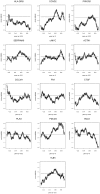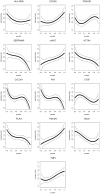A strategy for full interrogation of prognostic gene expression patterns: exploring the biology of diffuse large B cell lymphoma
- PMID: 21829609
- PMCID: PMC3150354
- DOI: 10.1371/journal.pone.0022267
A strategy for full interrogation of prognostic gene expression patterns: exploring the biology of diffuse large B cell lymphoma
Abstract
Background: Gene expression profiling yields quantitative data on gene expression used to create prognostic models that accurately predict patient outcome in diffuse large B cell lymphoma (DLBCL). Often, data are analyzed with genes classified by whether they fall above or below the median expression level. We sought to determine whether examining multiple cut-points might be a more powerful technique to investigate the association of gene expression with outcome.
Methodology/principal findings: We explored gene expression profiling data using variable cut-point analysis for 36 genes with reported prognostic value in DLBCL. We plotted two-group survival logrank test statistics against corresponding cut-points of the gene expression levels and smooth estimates of the hazard ratio of death versus gene expression levels. To facilitate comparisons we also standardized the expression of each of the genes by the fraction of patients that would be identified by any cut-point. A multiple comparison adjusted permutation p-value identified 3 different patterns of significance: 1) genes with significant cut-point points below the median, whose loss is associated with poor outcome (e.g. HLA-DR); 2) genes with significant cut-points above the median, whose over-expression is associated with poor outcome (e.g. CCND2); and 3) genes with significant cut-points on either side of the median, (e.g. extracellular molecules such as FN1).
Conclusions/significance: Variable cut-point analysis with permutation p-value calculation can be used to identify significant genes that would not otherwise be identified with median cut-points and may suggest biological patterns of gene effects.
Conflict of interest statement
Figures


Similar articles
-
Quantitative nuclease protection assay in paraffin-embedded tissue replicates prognostic microarray gene expression in diffuse large-B-cell lymphoma.Lab Invest. 2007 Oct;87(10):979-97. doi: 10.1038/labinvest.3700665. Epub 2007 Aug 13. Lab Invest. 2007. PMID: 17700562
-
Assessment of CD37 B-cell antigen and cell of origin significantly improves risk prediction in diffuse large B-cell lymphoma.Blood. 2016 Dec 29;128(26):3083-3100. doi: 10.1182/blood-2016-05-715094. Epub 2016 Oct 19. Blood. 2016. PMID: 27760757 Free PMC article.
-
Methylation silencing CDH23 is a poor prognostic marker in diffuse large B-cell lymphoma.Aging (Albany NY). 2021 Jul 12;13(13):17768-17788. doi: 10.18632/aging.203268. Epub 2021 Jul 12. Aging (Albany NY). 2021. PMID: 34252883 Free PMC article.
-
Gene expression profiling of diffuse large B-cell lymphoma.Leuk Lymphoma. 2003;44 Suppl 3:S41-7. doi: 10.1080/10428190310001623775. Leuk Lymphoma. 2003. PMID: 15202524 Review.
-
Diffuse large B-cell lymphoma.Pathology. 2018 Jan;50(1):74-87. doi: 10.1016/j.pathol.2017.09.006. Epub 2017 Nov 20. Pathology. 2018. PMID: 29167021 Review.
Cited by
-
Low GILT Expression is Associated with Poor Patient Survival in Diffuse Large B-Cell Lymphoma.Front Immunol. 2013 Dec 4;4:425. doi: 10.3389/fimmu.2013.00425. eCollection 2013. Front Immunol. 2013. PMID: 24409177 Free PMC article.
-
Geographic Distribution and Survival Outcomes for Rural Patients With Cancer Treated in Clinical Trials.JAMA Netw Open. 2018 Aug 3;1(4):e181235. doi: 10.1001/jamanetworkopen.2018.1235. JAMA Netw Open. 2018. PMID: 30646114 Free PMC article.
-
A comparative analysis of prognostic factor models for follicular lymphoma based on a phase III trial of CHOP-rituximab versus CHOP + 131iodine--tositumomab.Clin Cancer Res. 2013 Dec 1;19(23):6624-32. doi: 10.1158/1078-0432.CCR-13-1120. Epub 2013 Oct 15. Clin Cancer Res. 2013. PMID: 24130072 Free PMC article.
-
Deregulation of cell adhesion molecules is associated with progression and poor outcomes in endometrial cancer: Analysis of The Cancer Genome Atlas data.Oncol Lett. 2020 Mar;19(3):1906-1914. doi: 10.3892/ol.2020.11295. Epub 2020 Jan 13. Oncol Lett. 2020. PMID: 32194686 Free PMC article.
-
Colorimetric in situ hybridization identifies MYC gene signal clusters correlating with increased copy number, mRNA, and protein in diffuse large B-cell lymphoma.Am J Clin Pathol. 2013 Feb;139(2):242-54. doi: 10.1309/AJCP2Z0TAGMUYJEB. Am J Clin Pathol. 2013. PMID: 23355209 Free PMC article.
References
-
- Roberts RA, Sabalos CM, LeBlanc ML, Martel RR, Frutiger YM, et al. Quantitative nuclease protection assay in paraffin-embedded tissue replicates prognostic microarray gene expression in diffuse large-B-cell lymphoma. Laboratory Investigation. 2007;87:979–997. - PubMed
-
- Chang KC, Huang GC, Jones D, Lin YH. Distribution patterns of dendritic cells and T cells in diffuse large B-cell lymphomas correlate with prognoses. Clin Cancer Res. 2007;13:6666–6672. - PubMed
-
- Dave SS, Fu K, Wright GW, Lam LT, Kluin P, et al. Molecular diagnosis of Burkitt's lymphoma. N Engl J Med. 2006;354:2431–2442. - PubMed
-
- Hummel M, Bentink S, Berger H, Klapper W, Wessendorf S, et al. A biologic definition of Burkitt's lymphoma from transcriptional and genomic profiling. New England Journal of Medicine. 2006;354:2419–2430. - PubMed
Publication types
MeSH terms
Substances
Grants and funding
LinkOut - more resources
Full Text Sources
Other Literature Sources
Research Materials
Miscellaneous

